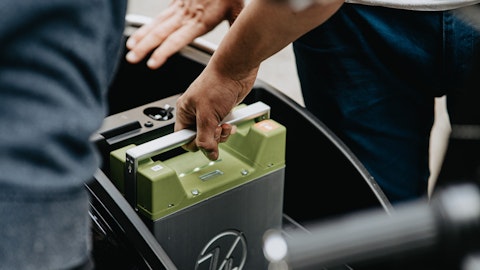The Australian scheme booklet, which includes the independent expert report, should be ready for Allkem’s investors shortly, and we also expect to provide the S4 proxy statement to Livent stockholders in the coming weeks. Once all relevant documentation is approved by the applicable regulators and distributed, Livent and Allkem will seek approval from their respective shareholders as special meetings expected to take place late in the fourth quarter. Dates for the votes should be announced shortly, and the transaction is still expected to close around the end of calendar year 2023. With your support, we look forward to combining our teams, assets and collective strengths to create a leading integrated global lithium company. I will now turn the call back to Dan for questions.
Daniel Rosen: Thank you, Paul. Paul, you may now begin the Q&A session.
Operator: [Operator instructions] We will first discuss the need to Kevin McCarthy at Vertical Research Partners.
Kevin McCarthy: Yes, good evening. Paul, as lithium market prices continue to descend, what destruction of supply have you witnessed, and where do you think prices might stabilize based on your forward view of demand?
Paul Graves: Yeah, look, I think we’ve seen probably three areas of supply interruption. The obvious one and we probably see a few announcements overnight last night coming out of China, where non-integrated producers are shutting down, whether that’s for extended maintenance periods or whatever the reason is. We’re certainly seeing the economics of running a plant such as that really require the producer to have two trade-offs. Keep the plant running and maybe cover your fixed costs and run on a contribution basis, but after a while, it just becomes too expensive, and so it’s cheaper to put the plant on hold for a while. So we’ve certainly seen a few of those. We’ve seen lipid light production reduce. It’s not always as clear as we would like, but some of the data I’ve seen suggests a 40% or so reduction in lipid light production starting to take place in China.
And frankly, we don’t see many people looking to maximize production from existing operations. I think where possible, people are looking to run the most efficient way that they can, and if that means maybe dialing back some production for a while, then that’s what we’ve seen some of them do at the margins and again, a few announcements suggesting that there will be production cuts from some existing operations out there. In terms of where it stabilizes, it’s a trillion-dollar question. I think you’ve heard me say in the past that pricing above $40, $50 a kilo just isn’t rational and couldn’t be justified by fundamentals. I think pricing at much below $20 a kilo with today’s supply curve also can’t be rationalized for a long period of time and isn’t supported by fundamentals.
Doesn’t mean it can’t happen for a couple of quarters. I think, again, you’ve probably heard me talk, this sort of, pick your number anywhere between low 20s and high 30s a dollar a kilo, depending on the grade, depending on the product, depending on the geography, seems to be a place that you get both appropriate return on existing assets, but also sufficient reinvestment economics to continue to invest in the assets. Unfortunately, I suspect pricing will be constantly passing through that range, upwards and downwards, for a few years still to come.
Kevin McCarthy: Thank you for that and then secondly, if I may, Paul, if the current production expectations hold in Argentina, how much would you expect your production capability to grow in 2024? Is it fair to say it would be perhaps 40% or more?
Paul Graves: I think by the end of the year, our production capability will be almost double what it is today in Argentina. In terms, if you talk about ability to produce and sell, and I’ve become a bit gun-shy over the challenges on commissioning, but certainly 40% is absolutely well within the range. The first expansion, 9,500 tons, is essentially largely complete today. It’s just this final commissioning step, and we’re hoping to start production at some point in December, which gives us commercial volumes early next year, month or two range of that and then it’s just a function of how quickly we ramp up, but certainly you can expect 7,000 tons, 8,000 tons, 9,000 tons more capacity, which itself represents, a 35% to 45% increase.
With the second phase also looking to be mechanically complete by the middle of the year, and we are, by the way, changing our commissioning process for the second phase to sort of have an ongoing commissioning rather than wait until all construction is complete in order to help accelerate the gap between construction completion and production. We certainly expect to get some volumes out of that second expansion too. So certainly in those kind of range numbers you’re talking about are absolutely base targets for us.
Operator: Thank you, we go next now to Chris Kapsch at Loop Capital Markets.
Chris Kapsch: Yeah, good afternoon. Curious about your comments about the de-stocking activity in China, juxtaposed against a comment about the end market demand remaining relatively stable or unchanged in terms of its growth. So just curious if you have any visibility into where that overbuild has happened? Has it been more a function of an overbuild of the overall giga factory capacity, or is it existing justifiable suppliers that just simply overbuilt their inventories as prices were going higher or maybe on bigger expectations of growth rates? Any visibility there?
Paul Graves: Yeah, look, I think the best I can offer you is the following. We characterize battery cell producers in China as tier one, two, and three. And we’ve certainly seen some of the larger tier two guys be particularly keen to pull back production, whether they were building to try and take market share from the big tier ones, whether they were running their assets at, if you built a plant and you’re running it at 25% utilization, that’s not economically sensible. So we’ve certainly believed that there’s been a number of producers out there running at the utilization rates that make the plant now profitable, but produce more cells than they actually have sold with the expectation that they can then go win market share by having these cells available.





